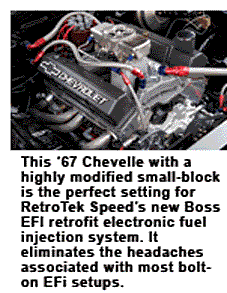It is rare that a new product comes along that redefines a category and a market. Take Apple’s iPod for example. Digital downloading and music file sharing was becoming popular, but a portable device to take your downloaded music with you was needed. Apple’s iPod did just that. Now it’s nearly impossible to go anywhere without seeing someone with an iPod attached to their head.
For many years there’s been a similar need in the aftermarket for an EFI system that was easily adaptable to carbureted engines. Due to the popular types of vehicles that are currently driving the aftermarket such as Restomods (pony and musclecars that retain the restored look but are modified to run, handle and drive like modern performance cars), Pro Touring (cars that look like race cars but are street driven), and G-Machines (’60s and ’70s cars set up with state-of-the-art suspensions and drivetrains), the need today is greater than ever. These ultra-modern performance vehicles disguised in vintage sheet metal are mostly tied to 100-year-old carburetor technology for number of reasons.

Some of the barriers that have slowed the spread of EFI to the retrofit aftermarket are: ECUs that don’t function as promised, or require an expert to tune. Added expense – it’s well-known that a good carb/manifold combination can make almost as much power for much less money. Additional factors are that transplanted O.E. TPI systems have flow limitations that ultimately limit an engine’s power output, and then there’s that esthetics thing – enthusiasts are hesitant to retrofit EFI to iconic vehicles because many EFIs are unattractive with the “bundle of snakes” wiring and hoses. It’s important to the classic muscle- and pony-car guys to maintain the carbureted “look” complete with the original cold-air system. Convenience has been a big factor too. Most EFI systems require a fuel tank return line that is a big hassle to install and a is permanent modification some enthusiasts are not willing to make.
An innovative new product is about to hit the market as you read this that should change everything we know and think about retrofitting EFI to carbureted vehicles. It will take the unnerving responsibility away from the engine builder concerning component compatibility issues too. RetroTek Speed is a small but dynamic aftermarket company in Corona, California that has just introduced a plug-n-play retrofit EFI system that self-learns (self-tunes) as you drive – no laptop or tuning skills required. RetroTek has made its EFI systems more attractive and user friendly by eliminating the need for a fuel return line back to the fuel tank, and by designing a wiring harness that has very few connections. RetroTek offer these systems in several versions such as throttle bodies that resemble classic Stromberg 97s for the nostalgic street rodder, to high-tech multiple Weber systems that are actually EFI throttle bodies disguised as Weber 48 IDA carburetors. But the real star in the lineup is the just-released BossEFI, which is a throttle-body-style injector that looks just like a high-performance, 4150-style dual inlet four-barrel carburetor.
Thanks to RetroTek’s revolutionary new self-learning Smart Tune Technology (STT) ECU, you or your customer doesn’t even have to program the system. Simply plug in the harness, hook up power and ground wires, and drive. Within minutes the vehicle will be running smoother and more efficiently than it ever could with a carburetor. Most importantly, the BossEFI fits on any 4150 style intake manifold, supports up to 1,200-horsepower (dual throttle bodies), and is fully compatible with blow-through and draw-through supercharger and turbo applications. Thanks to external dimensions identical to a standard carburetor, it will even fit under your stock air cleaner, Shaker hood scoop, or cowl induction. For the first time in history, enthusiasts can add a complete, high-performance, digital fuel injection system to any vehicle without hassling with complicated installations or advanced computer programs.

Here’s how it works. The patent-pending BossEFI Injector Body is dimensionally nearly identical to a standard carburetor (it even looks like a dual fuel inlet carburetor), yet represents a giant leap forward in fuel system technology. This is not like the old-fashioned TBI systems that were bulky and low-performance. The RetroTek Injector Body uses four port-style high-pressure fuel injectors, which are neatly packaged in a retro-styled end cap which acts as a fuel supply rail, injector retainer and pressure sensor mount all in one. Each high-pressure injector sprays into one of the four contoured max-flow venturis. The body flows 750-1,000 cfm, depending upon application. Three primary-secondary linkage options are available, 1:1 for ultra high-performance applications, a soft progression for streetcars, and a quick progression for drag racing. The unit is fully compatible with standard carburetor linkages and components, including nitrous and superchargers.
The second key component is the exclusive Retrotek Flow Control pressure regulator. Rather than forcing your customer to rip out their old fuel system and install complicated fuel return lines like traditional aftermarket EFI systems, the BossEFI only requires one fuel line and a standard EFI pump. The Flow Control system modulates the pulse-width of the fuel pump, meaning it can regulate the amount of pressure the pump makes to match fuel injector demand. This allows the ECU to modulate fuel pressure up to 60 times per second, so air/fuel ratios are always precise and there is never excess pressure in the line.
The “brain” behind the operation is the third and final component, the RetroTek Smart Tune Technology (STT) engine management box. About the size of a paperback book, the STT is a totally new concept in fuel injection control. Simply take it out of the box, plug it into any computer (desktop or laptop) with a USB or serial cable, and choose one of the pre-loaded programs that best describes your engine. Simply highlight, click, and you’re done. Then install the box in your car.
The Injector Body is pre-wired with a single wire harness, which snaps into the side of the STT. Add a positive and ground leads from the battery, an ignition lead, a lead from the coolant temp sensor in the intake, and a connect the wire from the wide band O2 sensor (this is the only modification you have to make to your carbureted vehicle), and you’re ready to go. Everything else is pre-wired. No fuel rails, no aditional sensors, no headaches. Hit the ignition and the basic tune will get the motor started. At that point the STT will start checking air/fuel ratios 60 times per second, until it creates it’s own fuel map. Drive around the block and the system will continue to learn, until engine operations reach peak efficiency. As your driving style changes, the STT will continue to adapt.
The RetroTek Speed BossEFI has undergone extensive dyno testing, and will meet or exceed carburetor and standard EFI system power numbers on even the most radical race motors. It is compatible with any engine using a 4-barrel intake manifold, and can also be used in pairs for large cubic-inch and supercharged applications. The BossEFI is also compatible with most ignition systems, including MSD, HEI, Pertronix, points, Ford Electronic, and even coil pack/crank trigger systems. It is also fully compatible with standard throttle linkage, cables, and even transmission kickdown cables.
What RetroTek has in effect accomplished is to put EFI within reach of anyone wanting to upgrade from a carburetor. In a matter of a couple of hours you can remove your carburetor and have your BossEFI up and running. Priced between $1,800-$2,500 depending on application, these units are about 30% less than other systems on the market.
From an engine builder’s perspective you no longer have to build the engine for EFI. The RetroTek ECU doesn’t care how much manifold vacuum is present – it not only senses throttle position and rpm but engine load as well. Engine builders can use their favorite cylinder head/intake manifold combination that they know works with a carburetor will also work for the BossEFI.
What are the BossEFI’s shortcomings? By design it is a throttle body system that gives up the fuel distribution advantages of port-type EFI, so the fuel distribution is only as good as the intake manifold it is being used on. Not a shortcoming…the sophisticated RetroTek ECU controls only the fuel map not the ignition. It was designed that way to make the system more affordable and so that it would integrate with your current ignition system.
Musclecar, hot rod, off-road, and even marine performance enthusiasts finally have a viable, inexpensive, easy-to-install fuel injection solution that offers all the performance, reliability, and efficiency of a finely tuned TPI system, with the simple installation or a standard carburetor.
Check out the photos and ask yourself carburetor or EFI? It’s really the best of both worlds!













